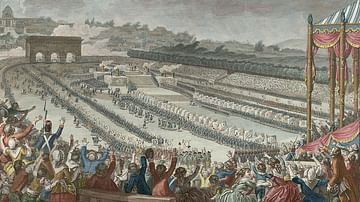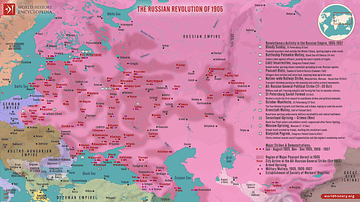Search
Search Results

Definition
Civil Constitution of the Clergy
The Civil Constitution of the Clergy was a law passed in July 1790 during the French Revolution (1789-1799), which caused the immediate subordination of the Catholic Church in France to the French government. An attempt to modernize the Church...

Definition
Festival of the Federation
The Festival of the Federation (Fête de la Fédération) was a celebration that occurred on the Champ de Mars outside Paris on 14 July 1790, the first anniversary of the Storming of the Bastille. With over 300,000 people in attendance, the...

Image
French Revolution and Wars 1789-99
A map illustrating the outbreak and course of the French Revolution (aka The Revolution of 1789 to distinguish it from the ones of 1830 and 1848) and the consequential conflicts between France, the largest and most populous state in Western...

Image
Map of the Russian Revolution of 1905
This map illustrates the Russian Revolution of 1905, a wave of political and social unrest across the Russian Empire following defeat in the Russo-Japanese War (1904-5). The revolution was sparked by Bloody Sunday on 22 January 1905, when...

Definition
Mercy Otis Warren
Mercy Otis Warren (1728-1814) was an American poet, playwright, and activist during the era of the American Revolution (1765-1789). Through her works of political satire, she advocated for the Patriot cause and became acquainted with several...

Image
The First Industrial Revolution, c. 1760 - 1840
An illustration depicting the First Industrial Revolution - a time of technological and scientific innovation that led to the rapid industrialization and urbanization of Europe and North America's agricultural economies (the term Industrial...

Image
The Scientific Revolution in Europe
The Scientific Revolution in Europe, roughly 1500 to 1700, was a profound intellectual and cultural transformation that forever altered humanity's understanding of the natural world. The period witnessed a seismic shift from medieval beliefs...

Image
An Allegory of the Revolution
Allégorie révolutionnaire ("Allegory of the revolution") by Nicolas Henri Jeaurat de Bertry, 1794. It was made in honor of Enlightenment philosopher Jean-Jacques Rousseau (1712-1778), whose portrait is seen at the top of the painting. Rousseau...

Definition
Long Barrow
A long barrow is a class of Middle Neolithic (approximately 3500-2700 BCE) burial monument which is found extensively throughout the British Isles and is related to other forms of contemporary tomb-building traditions of north-western Europe...

Definition
Banpo Village
Banpo Village is a Neolithic site in the Yellow River Valley, east of Xi'an, Shaanxi Province, in the People's Republic of China. The site was occupied from c. 4500-3750 BCE and covers almost 20 acres. Over 10,000 stone tools and artifacts...